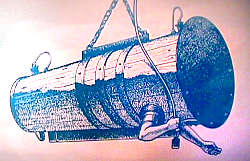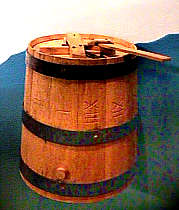The Undersea Museum
of the U.S. Navy
Keyport, WA
September 22nd, 2002
I have  always
been a military buff. I'm an old army brat. I was raised on stories
of Regiments and artillery and such. So while staying in Tok, Alaska, Laura
heard a radio broadcast describing the Undersea Museum of the US Navy. The
broadcast never gave a location and we were never able to find it, until Laura
got on the internet and looked it up. It turned out to be in Keyport, WA.,
some 1200 miles to the south. So, months later when we finally returned to the
lower 48 states, we ended up in northern Washington. Keyport is located on the
west side of Puget sound, about opposite to Seattle. In 1914, as war broke out
in Europe, the US Navy commissioned the Pacific Coast Torpedo Station who's job
it would be to test and evaluate torpedoes prior to them being pressed into
service. Today the mission is unchanged. At the base outside of Keyport,
WA., the testing and evaluating goes on. The Naval Undersea Museum displays many
of the artifacts
always
been a military buff. I'm an old army brat. I was raised on stories
of Regiments and artillery and such. So while staying in Tok, Alaska, Laura
heard a radio broadcast describing the Undersea Museum of the US Navy. The
broadcast never gave a location and we were never able to find it, until Laura
got on the internet and looked it up. It turned out to be in Keyport, WA.,
some 1200 miles to the south. So, months later when we finally returned to the
lower 48 states, we ended up in northern Washington. Keyport is located on the
west side of Puget sound, about opposite to Seattle. In 1914, as war broke out
in Europe, the US Navy commissioned the Pacific Coast Torpedo Station who's job
it would be to test and evaluate torpedoes prior to them being pressed into
service. Today the mission is unchanged. At the base outside of Keyport,
WA., the testing and evaluating goes on. The Naval Undersea Museum displays many
of the artifacts  of
that endeavor in a hands-on atmosphere that thrills the kids and fascinates the
adults, as well as bring tears of sadness or joy to old men who served in the US
submarine fleets of the last few wars. Admission is free, and no parking fee.
That in itself is a wonderful benefit. After passing through the lobby, we
entered a corridor who's walls displayed a timeline of the history to undersea
adventure with particular emphasis on military applications. One side
focused on the physical aspect while the other centered around the people who
made contributions. One of the first placards reported the diving
exploits of Gilgamesh
in 650 BC. He was a hero in ancient Sumer (now part of southern Iraq) and the
central character in the Epic of Gilgamesh. In one story, Gilgamesh dives
into the water abyss with stones tied to his feet to retrieve a plant that would
provide eternal life. After finding the plant he released the stones and
rises to the surface. Pearl divers still use this technique of tying
stones to their feet to descend to the bottom of the ocean. Like Gilgamesh,
their divers explore the sea without suits or breathing apparatus.
Gilgamesh lost the plant and did not become immortal. Other placards explained
how animal products were used to help humans dive. Divers in the
Mediterranean breathed underwater with animal skins or bladders filled with air.
In the Persian Gulf, divers used goggles made from tortoise shell. Leather
was used in many undersea applications because it was available,
of
that endeavor in a hands-on atmosphere that thrills the kids and fascinates the
adults, as well as bring tears of sadness or joy to old men who served in the US
submarine fleets of the last few wars. Admission is free, and no parking fee.
That in itself is a wonderful benefit. After passing through the lobby, we
entered a corridor who's walls displayed a timeline of the history to undersea
adventure with particular emphasis on military applications. One side
focused on the physical aspect while the other centered around the people who
made contributions. One of the first placards reported the diving
exploits of Gilgamesh
in 650 BC. He was a hero in ancient Sumer (now part of southern Iraq) and the
central character in the Epic of Gilgamesh. In one story, Gilgamesh dives
into the water abyss with stones tied to his feet to retrieve a plant that would
provide eternal life. After finding the plant he released the stones and
rises to the surface. Pearl divers still use this technique of tying
stones to their feet to descend to the bottom of the ocean. Like Gilgamesh,
their divers explore the sea without suits or breathing apparatus.
Gilgamesh lost the plant and did not become immortal. Other placards explained
how animal products were used to help humans dive. Divers in the
Mediterranean breathed underwater with animal skins or bladders filled with air.
In the Persian Gulf, divers used goggles made from tortoise shell. Leather
was used in many undersea applications because it was available, cheap and water-resistant. Diving suits, helmets, hoses, straps and seals
were all made of leather until well into the 19th century. Rubber and
rubber/cloth laminates eventually replaced leather in undersea devices. I found
it interesting that wood has been used in underwater devices for centuries.
Plentiful and cheap, wood was easily worked and could be made watertight.
Early diving bells were simply wooden casks, heavily weighted and turned
upside-down to trap a pocket of air. Divers swam into the cask and up to
the air pocket to catch a breath before swimming back out. Salvage diving
in the 1700s was done in a completely sealed wooden diving suit. The first
submarines were wooden until the early 1800s, when iron became plentiful and
easy to produce. Today synthetic and metal materials are stronger, cheaper
and more versatile than wood. and the use of wood as an undersea material has
declined. It took a good half an hour to get through the time-line. I learned
such trivia as the first submarine was built by Cornelius Van Drebbel in 1620.
Van Drebbel designed a boat to deliver a water petard - a bell-shaped bomb at
the end of a long pole or spar. Although Van Drebbel's invention was the
first operationally "successful" submarine. Attempts to use it as a
weapon were unsuccessful. And the first torpedo was invented by an Englishman
named Robert Whitehead. This self-propelled torpedo was 11 feet long,
weighed about 300 lbs and could travel at 6 knots for nearly 700 yards
Within 10 years, every major country except the US adopted the Whitehead design.
It and subsequent variations remained the standard in torpedoes right up until
the 1980s. The US developed its own, Howell torpedo which was based on
different principles. We passed out of the tunnel into a large open room with an
assortment of
cheap and water-resistant. Diving suits, helmets, hoses, straps and seals
were all made of leather until well into the 19th century. Rubber and
rubber/cloth laminates eventually replaced leather in undersea devices. I found
it interesting that wood has been used in underwater devices for centuries.
Plentiful and cheap, wood was easily worked and could be made watertight.
Early diving bells were simply wooden casks, heavily weighted and turned
upside-down to trap a pocket of air. Divers swam into the cask and up to
the air pocket to catch a breath before swimming back out. Salvage diving
in the 1700s was done in a completely sealed wooden diving suit. The first
submarines were wooden until the early 1800s, when iron became plentiful and
easy to produce. Today synthetic and metal materials are stronger, cheaper
and more versatile than wood. and the use of wood as an undersea material has
declined. It took a good half an hour to get through the time-line. I learned
such trivia as the first submarine was built by Cornelius Van Drebbel in 1620.
Van Drebbel designed a boat to deliver a water petard - a bell-shaped bomb at
the end of a long pole or spar. Although Van Drebbel's invention was the
first operationally "successful" submarine. Attempts to use it as a
weapon were unsuccessful. And the first torpedo was invented by an Englishman
named Robert Whitehead. This self-propelled torpedo was 11 feet long,
weighed about 300 lbs and could travel at 6 knots for nearly 700 yards
Within 10 years, every major country except the US adopted the Whitehead design.
It and subsequent variations remained the standard in torpedoes right up until
the 1980s. The US developed its own, Howell torpedo which was based on
different principles. We passed out of the tunnel into a large open room with an
assortment of interactive machines along the walls. This was where the kids got into the show.
There were things to pull and things to push and twist. Each one had a lesson to
learn. There were demonstrations on salinity, pressure, buoyancy, and the one I
found most interesting, sound. Since visible light is rapidly absorbed
underwater, sound must be used instead to "see" objects. In
1914, while working for the Submarine Signal Company (now part of
interactive machines along the walls. This was where the kids got into the show.
There were things to pull and things to push and twist. Each one had a lesson to
learn. There were demonstrations on salinity, pressure, buoyancy, and the one I
found most interesting, sound. Since visible light is rapidly absorbed
underwater, sound must be used instead to "see" objects. In
1914, while working for the Submarine Signal Company (now part of  Raytheon)
Reginald Fessenden demonstrated a device that transmitted sound waves and used
the echo to detect an underwater object. Word War I used
underwater sound research in locating submerged U-boats, but it was another 15
years before the Naval Research Laboratory was able to produce an operationally
useful sonar (SOund NAvigation Ranging) device. Today sonar devices are
used in virtually every underwater application as a substitute for vision.
The next room was the main area for the artifacts. The first item I found was an
original sea mine. The first American sea mine was used in 1777 during
the American Revolutionary War by David Bushnell, an American patriot.
Its purpose was to force British ships to give up their blockade of American
ports. Bushnell set watertight wooden kegs filled with gunpowder afloat in
the Delaware River near Philadelphia. When they came in contact with
British ships a spring loaded lever would trip a flintlock firing mechanism
detonating the kegs. Spread throughout the museum were little placards which
gave "DID YOU KNOW" statements.
Raytheon)
Reginald Fessenden demonstrated a device that transmitted sound waves and used
the echo to detect an underwater object. Word War I used
underwater sound research in locating submerged U-boats, but it was another 15
years before the Naval Research Laboratory was able to produce an operationally
useful sonar (SOund NAvigation Ranging) device. Today sonar devices are
used in virtually every underwater application as a substitute for vision.
The next room was the main area for the artifacts. The first item I found was an
original sea mine. The first American sea mine was used in 1777 during
the American Revolutionary War by David Bushnell, an American patriot.
Its purpose was to force British ships to give up their blockade of American
ports. Bushnell set watertight wooden kegs filled with gunpowder afloat in
the Delaware River near Philadelphia. When they came in contact with
British ships a spring loaded lever would trip a flintlock firing mechanism
detonating the kegs. Spread throughout the museum were little placards which
gave "DID YOU KNOW" statements.